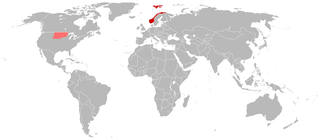
Norwegian is a North Germanic language spoken mainly in Norway, where it is the official language. Along with Swedish and Danish, Norwegian forms a dialect continuum of more or less mutually intelligible local and regional varieties, and some Norwegian and Swedish dialects, in particular, are very close. These Scandinavian languages, together with Faroese and Icelandic as well as some extinct languages, constitute the North Germanic languages. Faroese and Icelandic are hardly mutually intelligible with Norwegian in their spoken form because continental Scandinavian has diverged from them. While the two Germanic languages with the greatest numbers of speakers, English and German, have close similarities with Norwegian, neither is mutually intelligible with it. Norwegian is a descendant of Old Norse, the common language of the Germanic peoples living in Scandinavia during the Viking Era.
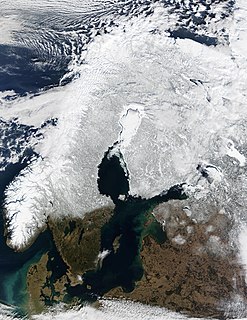
Scandinavia is a region in Northern Europe, with strong historical, cultural, and linguistic ties. The term Scandinavia in local usage covers the three kingdoms of Denmark, Norway, and Sweden. The majority national languages of these three, belong to the Scandinavian dialect continuum, and are mutually intelligible North Germanic languages. In English usage, Scandinavia also sometimes refers to the Scandinavian Peninsula, or to the broader region including Finland and Iceland, which is always known locally as the Nordic countries.

Denmark and the former political union of Denmark–Norway had a colonial empire from the 17th through the 20th centuries, large portions of which were found in the Americas. Denmark and Norway in one form or another also maintained land claims in Greenland since the 13th century.
Bokmål is an official written standard for the Norwegian language, alongside Nynorsk. Bokmål is the preferred written standard of Norwegian for 85% to 90% of the population in Norway. Unlike, for instance, the Italian language, there is no nationwide standard or agreement on the pronunciation of Bokmål.
Nynorsk is one of the two written standards of the Norwegian language, the other being Bokmål. Nynorsk was established in 1929 as one of two state-sanctioned fusions of Ivar Aasen's standard Norwegian language (Landsmål) with the Dano-Norwegian written language (Riksmål), the other such fusion being called Bokmål. Nynorsk is a variation which is closer to Landsmål, whereas Bokmål is closer to Riksmål.
The Danish and Norwegian alphabet, called the Dano-Norwegian alphabet is based upon the Latin alphabet and has consisted of the following 29 letters since 1917 (Norwegian) and 1948 (Danish).
Riksmål is a written Norwegian language form, meaning the National Language, based on the Dano-Norwegian language used by the upper class in Christiania in the 19th century.
The Norwegian Academy for Language and Literature, commonly known as the Norwegian Academy, is a Norwegian learned body on matters pertaining to the modern Norwegian language in its Dano-Norwegian variety, now commonly known as Riksmål and Bokmål. The academy was established in the Norwegian government's honorary residence Grotten in 1953 based on the model of the Swedish Academy and the French Academy, but the idea was originally conceived by Bjørn Bjørnson in 1913. Its members are elected for life on the basis of scholarly, literary or artistic merits. The academy publishes the main dictionary of Norwegian, Det Norske Akademis ordbok, is responsible for regulating the written standard known as Riksmål and has a literary and cultural purpose. The academy awards the Norwegian Academy Prize in memory of Thorleif Dahl.
The Danish West India Company or Danish West India–Guinea Company was a Dano-Norwegian chartered company that exploited colonies in the Danish West Indies.

The Kalmar War (1611–1613) was a war between Denmark–Norway and Sweden. Though Denmark soon gained the upper hand, it was unable to defeat Sweden entirely. The Kalmar War was the last time Denmark successfully defended its dominium maris baltici against Sweden, and it also marked the increasing influence of the two countries on Baltic politics.
Bergensk or Bergen dialect is a dialect of Norwegian used in Bergen, Norway. It is easy for Norwegians to recognise, as it is more distinguishable from other dialects in Hordaland than, for example, the Stavanger dialect (Stavangersk) from the dialects of Rogaland, and the Trondheim dialect from Trøndelag dialects.
Gøtudanskt/Dano-Faroese is a name for a variant of Danish language spoken in the Faroe Islands. Its intonation and pronunciation are influenced by Faroese.
Modern Norwegian is the Norwegian language that emerged after the Middle Norwegian transition period (1350-1536) and Dano-Norwegian. The transition to Modern Norwegian is usually dated to 1525, or 1536, the year of the Protestant Reformation and the beginning of the kingdom of Denmark–Norway (1536-1814).
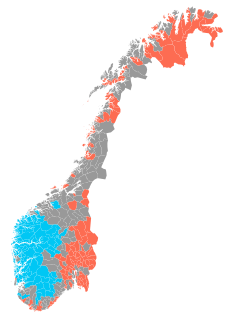
The Norwegian language conflict is an ongoing controversy within Norwegian culture and politics related to the written versions of the Norwegian language. From the 16th to the 19th century, Danish was the standard written language of Norway due to Danish rule. As a result, the development of modern written Norwegian has been subject to controversy related to nationalism, rural versus urban, Norway's literary history, dialect versus standard language, spelling reform, and orthography.
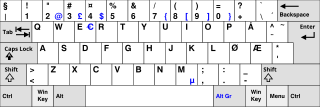
There are a large number of languages spoken in Norway. Of these, the Norwegian language is the most widely spoken and the main official language of the country.
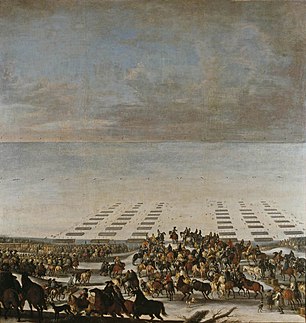
The Dano-Swedish War of 1657–58 was a conflict between Sweden and Denmark–Norway during the Second Northern War. In 1657, Charles X of Sweden and his Swedish army were bogged down in Poland. Frederick III of Denmark saw an opportunity to recover the territories lost in 1645 and attacked Sweden. The outbreak of war with Denmark provided Charles with an excuse to withdraw from the Polish campaign and move against Denmark.

Norwegian orthography is the method of writing the Norwegian language, of which there are two written standards: Bokmål and Nynorsk. While Bokmål has for the most part derived its forms from the written Danish language or the common Danish-Norwegian speech, Nynorsk gets its orthographical standards from Aasen's reconstructed "base dialect", which are intended to represent the distinctive dialectical forms. Both standards use a 29-letter variant of the Latin alphabet.

Denmark–Norway relations are foreign relations between Denmark and Norway. The countries have a very long history together: they were both part of the Kalmar Union between 1397 and 1523, and Norway was in Union with Denmark between 1524 and 1814.












